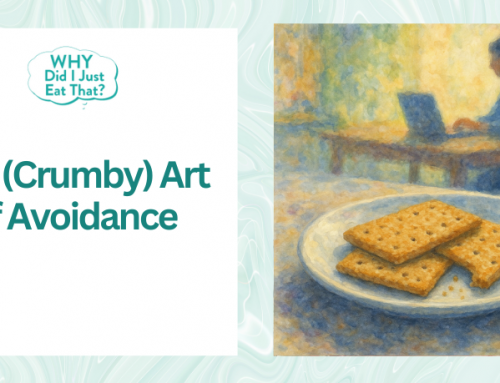 When I was in early elementary school—around first or second grade—I visited a classmate’s house to play. We weren’t close, but our mothers thought we might hit it off. Sorry to say, they were wrong. My new playmate was pretty mean to me, and I didn’t know how to stand up for myself. So, as I left her house, I committed one small act of rebellion: I snatched up a little rubber finger puppet from her room and slipped it into my jacket pocket.
When I was in early elementary school—around first or second grade—I visited a classmate’s house to play. We weren’t close, but our mothers thought we might hit it off. Sorry to say, they were wrong. My new playmate was pretty mean to me, and I didn’t know how to stand up for myself. So, as I left her house, I committed one small act of rebellion: I snatched up a little rubber finger puppet from her room and slipped it into my jacket pocket.
I felt awful about stealing (the first and only time I ever stole something); worse than I felt about being bullied, actually. I wanted to return it, which left me with a conundrum. How could I do it? I didn’t want another playdate at her house, and I couldn’t return the toy to her at school without it being obvious I had taken it. So the little finger puppet sat on my desk at home, staring at me accusingly. Eventually, my guilt became unbearable. So one day, I rode my bike past her house, stopping near her driveway. I pretended to inspect my front wheel, and subtly tossed the finger puppet onto her lawn. This half-hearted attempt at making amends slightly alleviated my shame, though I’m not sure it ever found its way back to her. This minor event has loomed large in my memory, likely because it wasn’t fully resolved.
For years, I was haunted by a lingering sense of shame for my six- or seven-year-old self. I’m sharing this story now because shame is a hot topic in discussions about certain eating disorders. Shame was even a theme in Oprah’s recent special, “Shame, Blame, and the Weight Loss Revolution.” While most people feel they understand shame, few can explain how it works.
Understanding how shame operates can be crucial for healing deep-seated issues, especially those related to food and eating.
Shame and Its Triggers
Shame is best described as that haunting, internal voice that tells us we are inadequate and flawed. It can be triggered by perceived shortcomings related to body image, eating habits, or failure to meet societal standards of size and appearance. Though often confused with guilt, shame and guilt are different.
The Cycle of Guilt
To understand shame, we must first understand guilt, as shame cannot exist without it.
Guilt arises when we violate a positive ideal we hold for ourselves. It follows a cycle:
Consider Amy, who believes that good people don’t yell at their mothers. But sometimes, Amy does yell at her mom. Does this make Amy a bad person? Well, Amy is concerned that it does mean she’s a bad person. Yet, Amy wants to believe she is a good person.
Enter Guilt
There is a loophole, though. Amy can avoid seeing herself as a bad person if she punishes herself a little for yelling instead of just yelling at her mom without any consequences. You see, by making herself feel guilty, Amy is essentially punishing herself. This way, she maintains her self-image as a “good person” despite sometimes acting in ways that aren’t so good.
The guilt cycle happens when someone does something they know is wrong but then feels bad about it (guilty) afterward. Guilt allows people to rationalize their mistakes. We tend to convince ourselves that we’ve somehow made up for our wrongdoings by feeling remorseful and inflicting emotional pain on ourselves. In Amy’s case, feeling guilty after yelling at her mom justifies her actions because guilt makes her feel like she’s still good at heart.
Understanding this guilt cycle is crucial to breaking it.
Breaking the Cycle of Guilt
Amy can stop feeling guilty by either changing her behavior (stopping the yelling) or adjusting her ideal standard (accepting that good people sometimes yell at their mothers). Flexible thinking is crucial for alleviating guilt. (For more on the value of flexible thinking, check out some of my previous blogs: here, here, and here.)
How Shame Differs from Guilt
While guilt arises from actions, shame traps us in a negative self-perception. To stop feeling guilty, we can change our actions or our opinions about those actions. But if we feel powerless to change our actions or situation, shame takes hold. Shame is the harsh inner critic that denies us the self-compassion we deserve.
Shame is often tied to secrecy. It’s understandable why someone feeling deep shame would try to hide aspects of their identity, past trauma, personal struggles, or perceived shortcomings. Secrecy can seem like self-preservation, as revealing these parts of ourselves might lead to judgment or rejection, reinforcing our feelings of defectiveness. However, secrecy also intensifies shame. Shame thrives in silence and secrecy.
However, there is a way to break free of shame: if we start examining the triggers that bring about our feelings of shame, and dare to acknowledge these triggers—even if only to ourselves—we might begin to dismantle the harmful influence shame has on our lives.
More on this in “What’s Shame Got to Do with It? Part Two”




